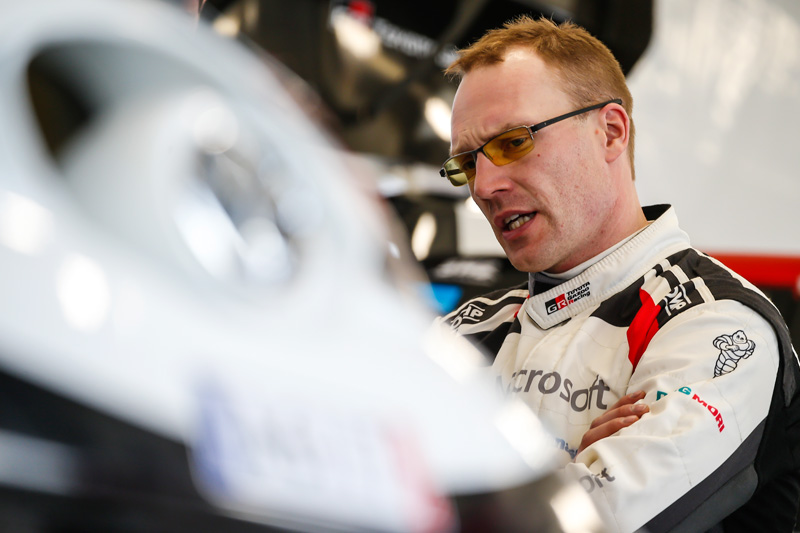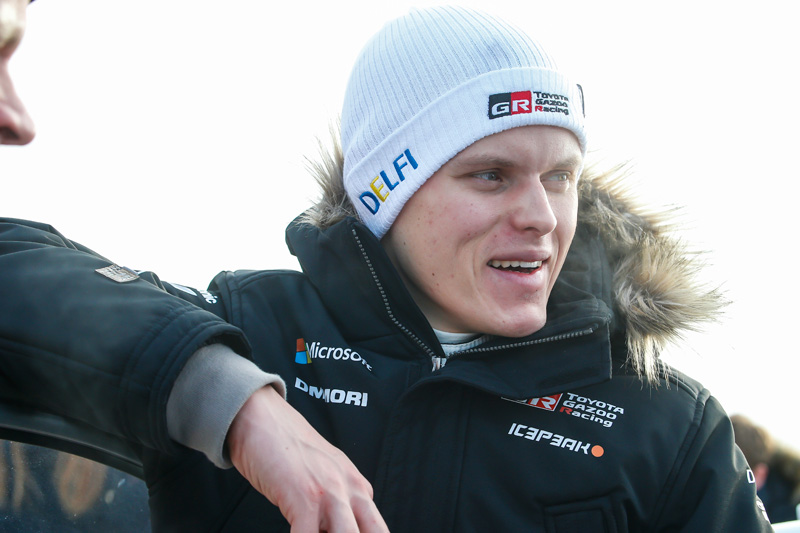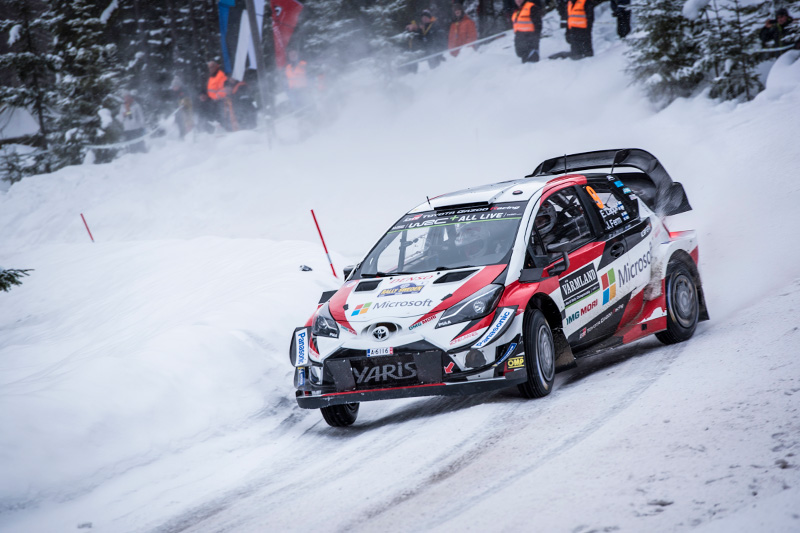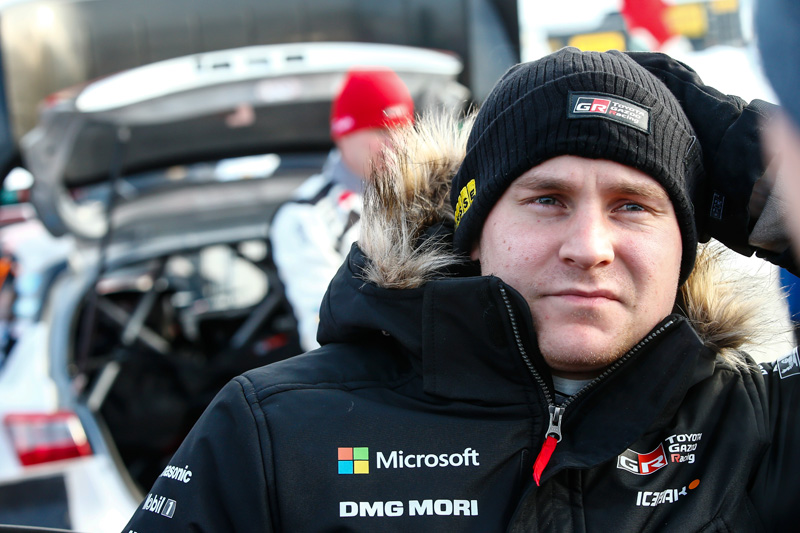RALLY SWEDEN
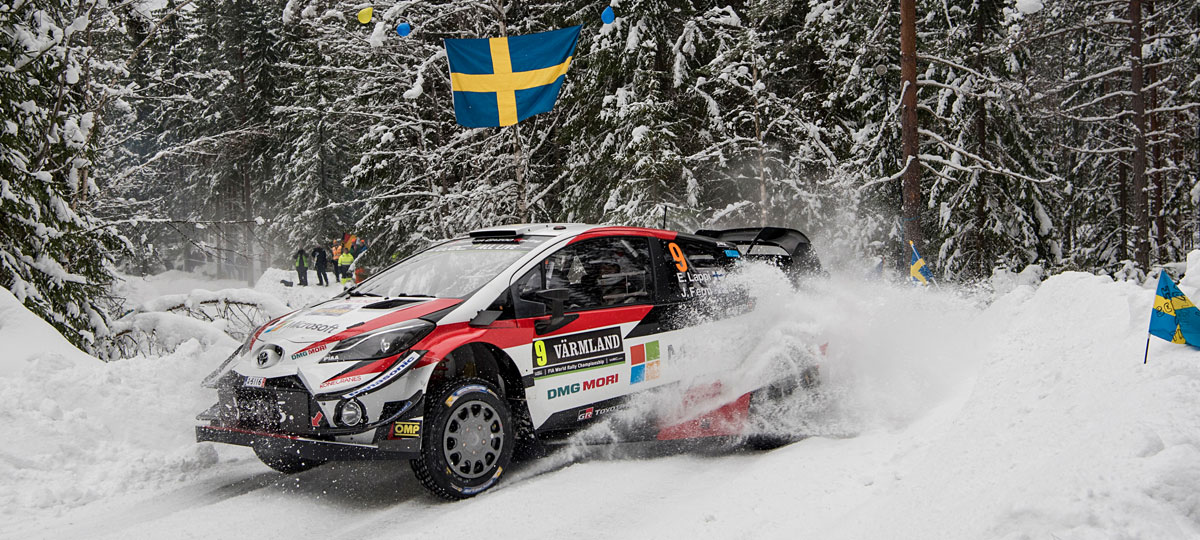
Heavy snow forces the frontrunners to compete in disadvantageous conditions, yet all three Yaris WRCs completed the rally and secure second place among manufacturer teams
For the TOYOTA GAZOO Racing World Rally Team, Rally Sweden brings back fond memories. In 2017, in only their second rally back in the WRC, Jari-Matti Latvala guided the Yaris WRC to its inaugural win. Rally Sweden is one of the events with high speed on the WRC calendar, despite taking place on snow roads, and the Yaris WRC demonstrated outstanding performance on its way to victory. It was a win founded on advanced aerodynamics, a powerful engine, and drivers who excelled in snowy conditions altogether. Keen to emulate their success from the previous year, the team carried out careful preparations. Aerodynamics, engine, suspension, and powertrain—every aspect of the vehicle was refined. The team’s three drivers each carried out two days of preparatory tests over snow roads, and arrived at the start of the rally full of confidence.
Road conditions are significantly affected by vast amounts of fresh snow
Having completed a two-day recce (an abbreviation of “reconnaissance,” where drivers check out the courses before the start of the rally), Latvala commented:
“This year there is a large amount of snow—the road conditions are fantastic. However, one thing worries me slightly, and that is the weather. It seems it will begin to snow on Thursday evening, and on Friday large amounts of snow will settle. If that happens, then the rally might become a little difficult.”
Following his victory here last year, Latvala is now a four-time winner of Rally Sweden. Hailing from Finland in Northern Europe, Rally Sweden is akin to a second home rally for him. For this reason, Latvala fully understands the difficulties that too much snow can bring. It is particularly problematic for drivers higher up in the starting order, since the special studded tires cannot achieve maximum effect in soft, fresh snow. To understand the difference in grip, imagine digging an icepick into hard-packed ice compared to digging one into shaved ice. On roads covered with hard-packed ice, the tire studs generate extremely high levels of traction; in fresh snow, however, they lose their efficacy and grip levels are substantially lower. As a consequence, fresh snow reduces the performance of rally cars when braking, cornering, and accelerating.
However, after the first few cars have passed over it, the fresh snow is driven away to reveal a surface of hard-packed ice underneath; this allows the studded tires to achieve their full potential. In other words, on roads covered with fresh snow, the starting order for the stage is crucial, with those starting later having an overwhelming advantage. On Day One of Rally Sweden, in the Super SS hosted on a short 1.9 km course inside a racetrack, the cars set off two at a time. The organizers were permitted to choose the starting order, and decided that the highest-ranked competitors would go last. However, for the genuine woodland SSs that were to begin on Day Two, the starting order was determined by driver placings in the overall championship standings. For this reason, Ott Tänak, who finished second at the previous rally in Monte Carlo, would start second, Latvala third, and Esapekka Lappi seventh.
Tänak recorded the best time on Day One’s Super Special Stage, while Latvala was second. The Yaris WRC demonstrated its full potential on flat surfaces of hard-packed snow. It was a strong start for the team. On Day Two, however, Latvala’s fears were realized. Weaving in and out of Sweden and neighboring Norway, the majority of stages on Day Two were covered with fresh, soft snow. Tänak managed to finish fastest on SS2; yet, from SS3 onwards, he lost a lot of time due to the fresh snow. Teammate Latvala suffered the same fate. In fact, all the drivers towards the top of the championship standings were forced to fight it out in disadvantageous conditions.
Ruts formed by classic cars have a major impact on the rally
It wasn’t just the fresh snow—ruts also had a major influence on driver times. After three stages were completed in the morning of Day Two, the Rally Sweden Historic took place. Compared to the latest world rally cars, the classic cars that competed in the Historic had narrower bodies and lower-powered engines. For this reason, they took significantly different lines into the corners to present-day world rally cars, and created deep and distinctive ruts in the surface of the snow. The repeat stages in the afternoon took place immediately after the Historic, and the drivers towards the top of the starting list had to cope with ruts that veered away significantly from optimal driving lines. Snow and ice that had been chipped away by the studded tires formed pools on the outside of the ruts, meaning there was little grip to be found there. As a result, the top starters not only had to contend with fresh snow in the morning, but also had to drive with patience in the afternoon.
After several world rally cars had passed, the ruts formed by the classic rally cars gradually began to disappear and the pools of snow were dispersed, leaving the road surfaces comparatively flat. The later starters therefore had an advantage in the afternoon stages again, and almost insurmountable time gaps were created over the course of a single day. Although Latvala finished Day Two in eighth and Tänak in ninth, their rivals who had started the rally in first and fourth in the championship standings were even lower. No matter how able the cars and drivers, there was no way of overcoming the disadvantages conferred by the starting order. Of course, this is unavoidable in a sport where competitors battle amid nature.
For the duration of Rally Sweden, both Latvala and Tänak battled against severe conditions and finished in a disappointing seventh and ninth place respectively. Nevertheless, on stages with comparatively favorable surface conditions, Tänak recorded six fastest times—the most among all the drivers in the rally. Tänak summarized Rally Sweden in the following way: “If the driving conditions had been the same for everyone, then the Yaris WRC would have won—its performance on snow roads is that good. The result was disappointing, but the rally was extremely enjoyable to drive.”
Lappi take the Power Stage in his first appearance in a world rally car in Sweden
Lappi was slightly lower down the starting order than his teammates. He showed outstanding speed, and was even in second place overall for a while. Lappi was making his first appearance at Rally Sweden in a world rally car, and for this reason he erred on the side of caution in his driving; yet he still had the speed to be competitive at the top of the standings. Unfortunately, Lappi struck a snow wall with his Yaris WRC during SS6 on Day Two. Snow was pushed into his car’s air cleaner, resulting in a significant loss of power. This accident cost Lappi 30 seconds or so and dropped him down to seventh overall, but he recovered by winning two stages on the final day of the rally. One of these wins was on the final Power Stage, where bonus points are given to the top five finishers. He took the full five points on offer. As a result, Lappi rose to fourth in the overall standings, and he finished his first-ever snow rally in a world rally car in excellent form.
This year’s edition of Rally Sweden was unique in that none of the top four drivers had a chance of winning. However, the TOYOTA GAZOO Racing World Rally Team was able to learn a great deal. In order to fight for the manufacturer’s championship, the team will have to demonstrate outstanding performance for the entire season. When faced with disadvantageous conditions, it will have to remain strong and continue to accumulate championship points steadily. To this end, it was significant that all three Yaris WRCs managed to complete the rally and accumulate points despite the adverse conditions. —Rally Sweden turned out to be a valuable event that bodes well for the future of the TOYOTA GAZOO Racing World Rally Team.
RESULT
| Pos | Driver | Co-Driver | Vehicle | Time |
|---|---|---|---|---|
| 1 | Thierry Neuville | Nicolas Gilsoul | Hyundai i20 Coupe WRC | 2h52.13.1s |
| 2 | Craig Breen | Scott Martin | Citroen C3 WRC | +19.8s |
| 3 | Andreas Mikkelsen | Anders Jaeger | Hyundai i20 Coupe WRC | +28.3s |
| 4 | Esapekka Lappi | Janne Ferm | Toyota Yaris WRC | +45.8s |
| 5 | Hayden Paddon | Sebastian Marshall | Hyundai i20 Coupe WRC | +54.4s |
| 6 | Mads Østberg | Torstein Eriksen | Citroen C3 WRC | +1m15.3s |
| 7 | Jari-Matti Latvala | Miikka Anttila | Toyota Yaris WRC | +2m04.9s |
| 8 | Teemu Suninen | Mikko Markkula | Ford Fiesta WRC | +2m52.2s |
| 9 | Ott Tänak | Martin Järveoja | Toyota Yaris WRC | +3m44.4s |
| 10 | Sebastien Ogier | Julien Ingrassia | Ford Fiesta WRC | +8m45.4s |

